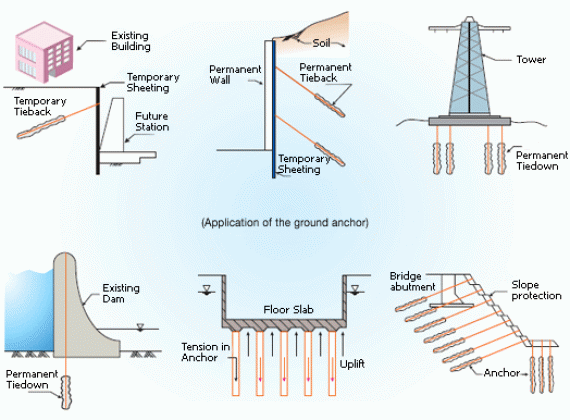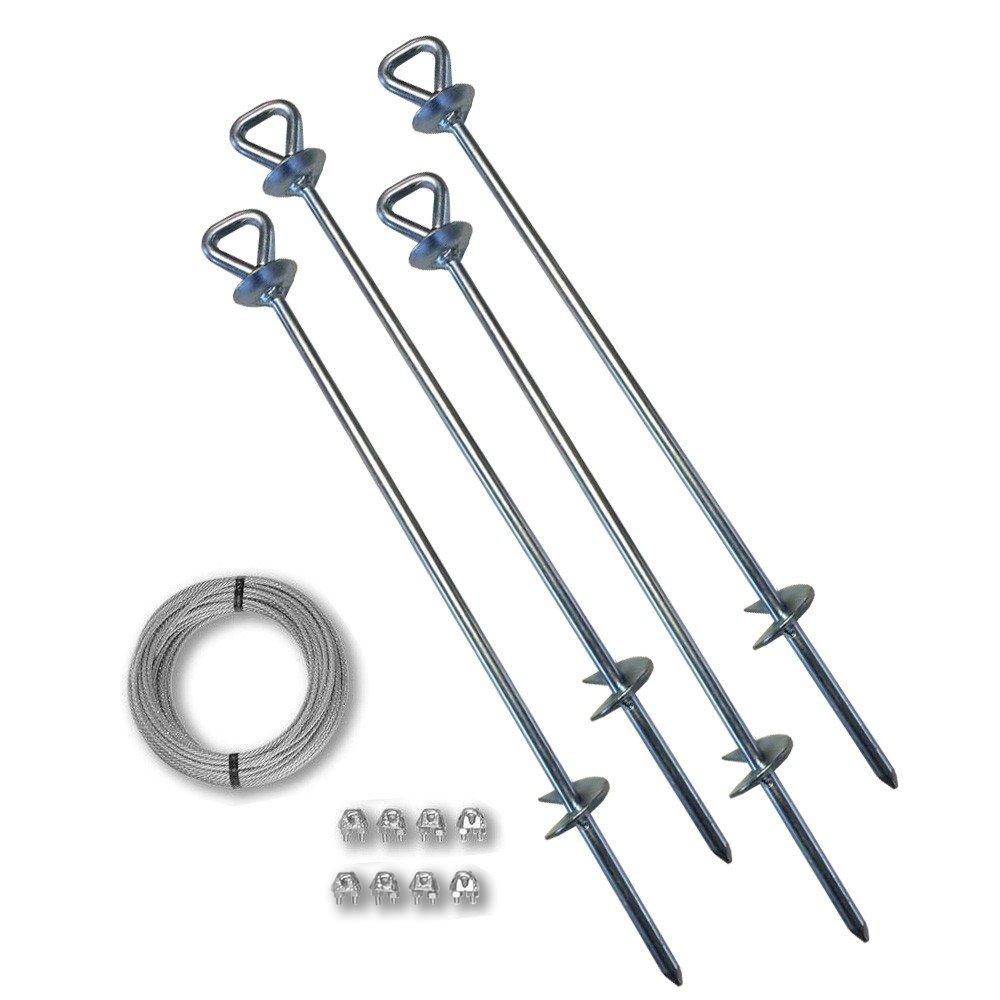Just How Heavy-Duty Earth Anchors Job: A Comprehensive Guide to Soil Anchoring Solutions
Sturdy Earth anchors play an important duty in giving security and assistance in various construction applications. By embedding deeply right into the ground, they resist side and vertical pressures successfully. Different kinds of supports satisfy different dirt conditions, making them versatile. Recognizing their technicians and setup strategies is important for making the most of performance. What aspects influence their effectiveness, and just how do they compare to traditional methods? The solutions might surprise you.
Understanding Durable Earth Anchors
Sturdy Earth supports work as vital parts in numerous construction and landscaping jobs, offering security and assistance in tough dirt problems. These anchors work by being installed right into the ground, where they withstand upright and side pressures. Their design enables safe add-on to frameworks, guaranteeing they stay secured against soil activity or exterior loads.The performance of durable Earth supports mainly relies on the sort of soil and the anchor's setup depth. Appropriate setup strategies are vital, as they determine the anchor's holding ability. Ecological aspects, such as wetness and freeze-thaw cycles, can additionally influence performance.These supports are regularly utilized in applications varying from safeguarding fencings and preserving walls to maintaining temporary structures throughout damaging climate problems. Recognizing the principles behind durable Earth anchors is essential for experts seeking to boost the longevity and security of their jobs.
Kinds Of Heavy-Duty Earth Anchors
Different kinds of heavy-duty Earth anchors are made to fulfill particular requirements based on dirt problems and task needs. Helical anchors, featuring screw-like blades, are reliable in softer dirts, offering high load capacities and simple installation. Driven anchors, which are hammered right into the ground, appropriate for rocky terrains and supply immediate lots assistance. Tie-back supports are typically used in preserving wall surface applications, enabling lateral support by securing into the ground at an angle. Another type is the cast-in-place anchor, suitable for concrete applications, as they are incorporated into structures for improved security. Soil screw anchors are functional options that can be utilized in various soil types, supplying dependable tension and compression capabilities. Each kind offers distinct applications, guaranteeing security and safety in building and landscape design projects. Understanding these options enables educated choices in choosing the suitable Earth anchoring remedy.
The Mechanics of Soil Anchoring

Recognizing the auto mechanics of soil anchoring requires an assessment of various types of Earth anchors and their installment techniques. Each support kind presents unique qualities that affect its performance in various dirt conditions. Correct setup techniques are essential for making best use of the securing system's security and performance.
Sorts Of Earth Anchors
Earth anchors, crucial elements in dirt anchoring systems, can be found in several kinds, each made for details applications and dirt problems. One of the most usual kinds consist of screw supports, which are twisted into the ground, giving strong side resistance. Helical anchors feature blades that enable efficient installation in various soil types, making them suitable for both temporary and long-term applications. Driven supports, typically made from steel, are inculcated the dirt and are effective in dense or rocky environments. Auger supports utilize a helical style to help with setup in softer dirts. Plate anchors are composed of a flat plate hidden flat, distributing lots over a larger area, ideal for applications needing high load capacities in natural soils.
Installation Strategies Explained
Appropriate setup strategies are essential for the effectiveness of soil anchoring systems. The process normally begins with website assessment, validating the chosen area can sustain the anchor's tons. After identifying the appropriate anchor type, appropriate opening deepness and angle must be developed. The installment entails driving the anchor right into the ground using customized tools, such as hydraulic or hand-operated drivers, to attain ideal embedment. Post-installation, tensioning the support is important to ensure security; this is typically confirmed with load screening. Additionally, surrounding dirt problems must be kept track of to avoid displacement. Following these strategies not just enhances the anchor's performance yet also extends its life-span, offering dependable assistance for various applications.
Applications of Heavy-Duty Earth Anchors
While sturdy Earth anchors are frequently linked with building and construction and landscape design, their flexibility reaches a range of applications throughout different markets. In civil design, they give essential support for keeping walls, making sure security in areas prone to soil erosion. The aquatic market utilizes these supports great post to read for protecting docks and marinas, preventing activity created by tides and currents. Additionally, in the telecom market, durable Earth supports are substantial go to this website for maintaining cell towers and other high structures versus wind forces. Agricultural applications likewise benefit, as these supports can safeguard frameworks like greenhouses and animals fence, guaranteeing they stand up to extreme climate condition. In sustainable energy tasks, such as wind ranches, Earth supports play an important duty in securing generator structures, enhancing overall safety and security and performance. This wide variety of applications highlights the adaptability and dependability of heavy-duty Earth anchors throughout various fields.
Advantages Over Standard Anchoring Methods
Although typical anchoring techniques have long been trusted for stability, heavy-duty Earth supports provide significant advantages that improve efficiency and efficiency. One major benefit is their superior load-bearing capability, which permits them to endure greater pressures without failing. This stamina makes them ideal for requiring applications, such as in building and utility installations.Additionally, heavy-duty Earth anchors are developed for deeper setup, offering higher stability in different dirt conditions, including loose or sandy soils. Their resistance to deterioration and ecological elements ensures a longer life-span and lowered maintenance expenses compared to standard methods.Moreover, these anchors can be installed with minimal disruption to the surrounding location, preserving the honesty of the landscape. In general, durable Earth supports present a effective and reputable solution for anchoring demands, surpassing the restrictions often connected with traditional anchoring techniques.
Setup Refine and Finest Practices
The setup check my source process for soil securing remedies starts with complete preparation and site assessment to ensure peak performance. Following this, a step-by-step installation guide supplies clear instructions for effective application (tensile load anchors). Following these best methods is vital for achieving resilient and reputable anchoring results
Preparation and Site Analysis
Efficient prep work and thorough website analysis are important actions in the setup of soil anchoring services. Before setup, the soil type must be assessed to establish its bearing ability and viability for anchoring. Conducting a geotechnical study can provide crucial info regarding soil structure, wetness levels, and possible ground motion. Additionally, identifying existing frameworks, plants, and energies is important to prevent disturbance during installment. The area must be free from particles and challenges to ensure secure accessibility for tools. Climate condition should also be kept track of, as damaging conditions can influence both safety and security and installation effectiveness. By meticulously preparing the site and reviewing all appropriate variables, the likelihood of successful support performance is substantially increased.
Step-by-Step Setup Overview
A thorough setup procedure is vital for accomplishing suitable performance of dirt anchoring remedies. The installment starts with selecting the proper anchor type and ensuring the website is clear of debris. Next, appropriate opening positioning is identified based on load demands. As soon as the area is established, openings are pierced to the defined depth and size making use of the correct tools. The support is after that placed right into the opening, making sure it is aligned correctly. After safeguarding the support, soil is backfilled and compacted to improve stability. It is necessary to adhere to manufacturer standards throughout the procedure. A post-installation inspection verifies that the supports are adequately positioned and functioning as intended, giving reliable support for the intended application.

Maintenance and Examination of Earth Anchors
Routine upkeep and inspection of Earth anchors are necessary for guaranteeing lasting performance and stability. Periodic checks permit the very early discovery of issues such as deterioration, loosening, or dirt movement. Examiners need to try to find signs of rust or destruction on the anchor parts, particularly at the link factors. Additionally, the surrounding soil must be assessed for disintegration or modifications in moisture material, which can influence support effectiveness.It is advisable to develop a routine assessment timetable, ideally at the very least annually, depending upon environmental conditions. During assessments, all noticeable components need to be cleansed to get rid of dust or debris that can conceal possible troubles. Any indications of distress, such as turning structures or uncommon settling, should prompt instant examination. Appropriate documents of inspections can aid in monitoring support performance with time and facilitate timely upkeep activities, making certain the supports stay trusted and practical.
Regularly Asked Concerns
What Products Are Heavy-Duty Earth Anchors Commonly Made From?
Durable Earth supports are generally created from sturdy materials such as galvanized steel or stainless steel, ensuring strength and resistance to rust. These products supply long-lasting assistance and stability in numerous dirt problems and applications.
Exactly How Do Dirt Problems Affect Support Performance?
Dirt problems considerably affect anchor efficiency. Elements such as soil kind, dampness content, and compaction impact the support's hold and security, with natural soils commonly giving better resistance than sandy or loose soils, influencing general effectiveness.
Can Heavy-Duty Earth Anchors Be Reused After Elimination?
Heavy-duty Earth supports can be reused after elimination, provided they are evaluated for damage and wear. Appropriate cleaning and maintenance boost their durability, making certain reliable efficiency in subsequent installations when conditions enable secure reinstallation.
What Are the Ecological Impacts of Using Earth Anchors?
The environmental effects of making use of Earth supports consist of possible dirt disturbance, disruption of local environments, and feasible contamination of groundwater. If utilized properly, their benefits typically outweigh these problems, advertising security in different applications.
Just how Do I Pick the Right Support for My Task?
